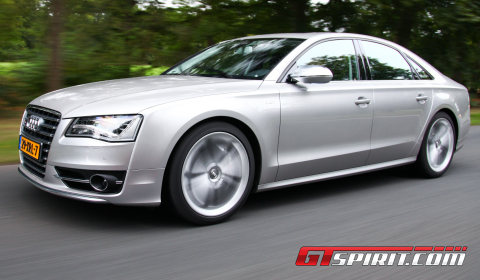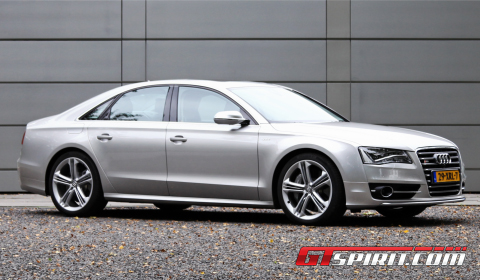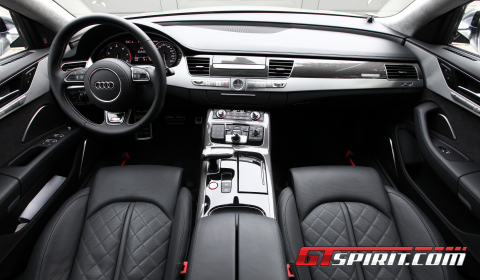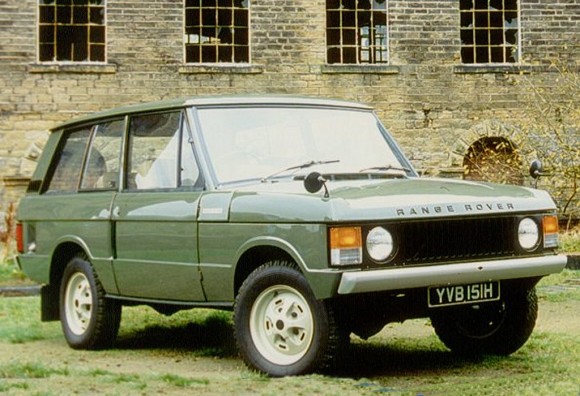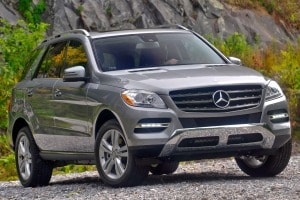
It's flying.
An instant after being launched by a hump in the road at
over 100 mph, my view of the sky from the central driving position of the
McLaren Fl supercar is pure Cinemascope. The moon could be our destination. In
that airborne instant, I believe anything is possible. Forget the moon—with an
engine this potent, let's aim for Mars.
When the four-point touchdown comes, it is so velvety that
the suspension feels as though it might have been designed for landings.
Instantly, the sound of rushing air is shattered by a sharp bark from the
engine as the $815,000 McLaren is propelled down the blacktop, accelerating at
a rate I've never before experienced. Foot down hard, the straight vanishes. As
the speedo needle hits 125 mph, an instant shift—so precise and mechanical it's
like pulling back a well-oiled bolt on a rifle—brings fourth gear and another
disorienting burst of power that thrusts me forcefully back into the tight-fitting
bucket seat.
Still we accelerate. Just 5.4 seconds later, a green
up-shift light flashes, appropriately positioned at the 7500 rpm redline on the
tach in the center of the instruments. Into fifth gear at 150 mph. Still no
lessening of acceleration thrust. The car—squat, stable, a green limpet on the
road—shoots forward. Maybe there's space before the corner to grab sixth at 180
mph. Maybe.
No. My courage runs out, the survival instinct takes over.
Onto the brakes. I press hard, through the pedal's inert feel before they bite
to blunt forward movement.
Less than 30 seconds earlier, I'd waited back up the road
for an all-clear signal. Even as the BMW V-12 idled evenly at 900 rpm, I could
sense its invincibility. The exhaust note might be subdued, but caress the
throttle and the revs soar. I can't resist. Nobody could. This engine responds
so instantly it feels as if it doesn't have a flywheel, like a racing engine.
The induction bellow is almost ephemeral it can be timed so accurately. The
tach needle jerks savagely around the gauge, as if directly connected to the
crankshaft.

I'm alone at last, able to contemplate the enormity of a car
so swift that it demands an utterly different mental approach. The McLaren
forces restraint because there is no way to drive it legally—except on an
autobahn or a racetrack—and even begin to probe the full extent of its power
and speed. It's an event every time you floor the throttle, producing an irresistible
desire to remain behind the wheel, to learn as much as possible about a car so
intense in its focus, so single-minded in its approach, that I'm convinced even
a top-ranked driver could own it for years and still not explore the outer
limits of its staggering performance envelope.
Forget the Jaguar XJ220, Bugatti EB110, Ferrari F40—until
now cars deserving to be called rapid. The McLaren blitzes them all. And we
have the proof. Confirmed by the Datron optical test gear.
The numbers do the talking: The F1 blasts to 60 mph in 3.2
seconds. The Porsche 959, the previous production-car record holder, needed 3.6
ticks of the watch. We saw 100 mph in 6.3 seconds. The Ferrari F40 took two
seconds longer. The McLaren hits 150 mph in 12.8 seconds, a smidgen longer
than it takes Porsche's latest, greatest 911 to reach 100 mph. Put
another way, the McLaren can accelerate as hard at 150 mph as a Ford Taurus can
in first gear.
Zero to 200 mph takes 28.0 seconds. What's impressive is the
figures show that above 125 mph, the Fl supercar accelerates faster than last
year's McLaren MP4/8 Grand Prix race car.
The standing quarter-mile is dispatched in a dazzling 11.1
seconds at 138 mph—about a second quicker and 15 mph faster than any other
supercar we've tested
Suddenly all the usual measures of performance seem mildly
laughable. We're talking about a road car that surpasses the performance of
most of the racers that will line-up for this year's 24 Hours of Le Mans race.
Top speed? The Fl runs into the 7500 rpm redline in sixth at
221 mph—but it's still accelerating. Gordon Murray, the F1's designer, is
convinced that with taller gearing, the car is capable of at least 230 mph.
The motivation behind this speed is a normally aspirated,
6.1-liter V-12, custom-designed for the McLaren F1 by BMW Motorsports. It
breaks the magic 100-horsepower-per-liter barrier, yet it is not about power
alone, although its 618 hp at 7400 rpm might convince you otherwise.
Helped by BMW's variable valve timing, Paul Roche's
masterpiece also pumps out a staggering 479 pound-feet of torque between 4000
and 7000 rpm. At only 1500 rpm, it produces 280 pound-feet. Try trickling along
at 1300 rpm in sixth gear and the spread of torque is confirmed, the
flexibility so astonishing that unless you glance at the tach, you have no idea
of the engine rpm. Floor the accelerator and while there's a trace of engine
knock, the acceleration is still assertive.
Such a tractable nature is confirmed by the top-gear
acceleration times. Although the engine is only turning 1000 rpm at 30 mph in
sixth gear, 50 mph comes up in only 7.0 seconds. From 50 to 70 mph, the engine
has picked up enough rpm and torque that the time drops to a mere 3.7 seconds.
A Lamborghini Diablo needs 7.5 seconds to cover the same interval in top gear
and the F40 needs 12.2 seconds.
Best of all, whatever the right foot does is instantly
translated to the rear wheels in a way no turbo engine can emulate. This
combination of flexibility and sheer muscle, the perception that the engine is
never stressed, together with the howl of a big-capacity V-12 when accelerating
and its relative hush at a constant throttle, ensures that this is undoubtedly
the finest high-performance production engine in the world.
Suddenly all the usual measures of performance seem mildly
laughable. We're talking about a road car that surpasses the performance of
most of the racers that will line-up for this year's 24 Hours of Le Mans race.
Top speed? The Fl runs into the 7500 rpm redline in sixth at
221 mph—but it's still accelerating. Gordon Murray, the F1's designer, is
convinced that with taller gearing, the car is capable of at least 230 mph.
The motivation behind this speed is a normally aspirated,
6.1-liter V-12, custom-designed for the McLaren F1 by BMW Motorsports. It
breaks the magic 100-horsepower-per-liter barrier, yet it is not about power
alone, although its 618 hp at 7400 rpm might convince you otherwise.
Helped by BMW's variable valve timing, Paul Roche's
masterpiece also pumps out a staggering 479 pound-feet of torque between 4000
and 7000 rpm. At only 1500 rpm, it produces 280 pound-feet. Try trickling along
at 1300 rpm in sixth gear and the spread of torque is confirmed, the
flexibility so astonishing that unless you glance at the tach, you have no idea
of the engine rpm. Floor the accelerator and while there's a trace of engine
knock, the acceleration is still assertive.
Such a tractable nature is confirmed by the top-gear
acceleration times. Although the engine is only turning 1000 rpm at 30 mph in
sixth gear, 50 mph comes up in only 7.0 seconds. From 50 to 70 mph, the engine
has picked up enough rpm and torque that the time drops to a mere 3.7 seconds.
A Lamborghini Diablo needs 7.5 seconds to cover the same interval in top gear
and the F40 needs 12.2 seconds.
Best of all, whatever the right foot does is instantly
translated to the rear wheels in a way no turbo engine can emulate. This
combination of flexibility and sheer muscle, the perception that the engine is
never stressed, together with the howl of a big-capacity V-12 when accelerating
and its relative hush at a constant throttle, ensures that this is undoubtedly
the finest high-performance production engine in the world.

Problems? Only a reverse gear that's difficult to engage.
You pay a price for this performance at the gas pump, yet
the efficiency of the engine, a drag coefficient of just 0.32, and the enormous
benefits of a light 2579-pound curb weight mean consumption is reasonable. On a
diet of unleaded premium, it still returns 19.3 mpg at highway speeds. Thrash the
car and it drops to just 9 mpg.
Crucial to the McLaren's handling excellence are three key
factors: the central driving position, the car's diminutive dimensions, and a
unique patented suspension system.
The advantages of the central driving position are many: the
driver can be positioned further forward, his legs slotted between the wheel
arches in two long carbon-fiber beams that house the controls. The
relationship with an F1 racing car is obvious. There are no offset pedals, and
the tiny, almost-vertical steering wheel is positioned so the driver's right
hand drops from the rim to the alloy gear lever.
From this position and without the hindrance of an
A-pillar, you can see the pavement just five feet in front of the car through
the huge windshield. You quickly learn that the compact Fl—it's about nine
inches narrower and seven inches shorter than a Diablo—can be placed within
inches of the apex. And because the driver is sitting in line with the roll
center, any impression of body roll—and there is a little—is removed.
Handling? You won't find a finer supercar chassis in the
world. There are compromises in building a car to be obedient while driving
slowly, yet with the stability required to cope with warp speeds and extreme
g-forces, but in the McLaren there are few of the design botches we've accepted
as normal in cars of this breed. Yes, the suspension is firm, the tires noisy,
and the ride at low speeds and on highways jiggly (especially for the
passengers). Yet on interesting back roads—where it counts—the suppleness and
composure are remarkable
There is no ignoring the weight of the steering when
parking, but above school-zone speeds, the steering has an almost meaty
precision to its feel. Low-speed corners suggest that the steering is low-geared.
Wrong. With 2.8 turns lock to lock, the steering is direct and alive, full of
feel yet without kickback.
On slow corners, the combination of an exceptional
power-to-weight ratio and a driver-oriented chassis allows you to turn into a
comer with just a tinge of understeer and then powerslide through it, balancing
the car by using both throttle and steering. The power oversteer is so
progressive that one does not hesitate to exploit it, despite the consequences
of crashing this $815,000 machine.
Ultimately, the McLaren does exactly what it is asked to do.
In fast corners, it grips surely and precisely. Unless you have the responses
of a Keke Rosberg—one of the F1's early customers—you run out of bravery, as
the strength of the g-forces builds up, long before the McLaren loses adhesion
or poise.
It is this certain predictability of behavior, the
instantaneousness of every dynamic aspect, that makes the F1 so secure to
drive, yet because the levels of performance are so high, the driving challenge
remains intense and involving.
Only in one area does the no-compromise approach suffer.
Finding the right disc-brake pads to cope with slow driving, and dealing with
the rigors of 200-mph stops, means the massive, vented four-caliper but
non-assisted brakes feel wooden when the pedal is first pressed upon. They need
a strong right foot and most drivers would probably appreciate an anti-lock
system.
There is no ignoring the weight of the steering when
parking, but above school-zone speeds, the steering has an almost meaty
precision to its feel. Low-speed corners suggest that the steering is
low-geared. Wrong. With 2.8 turns lock to lock, the steering is direct and
alive, full of feel yet without kickback.
On slow corners, the combination of an exceptional
power-to-weight ratio and a driver-oriented chassis allows you to turn into a
comer with just a tinge of understeer and then powerslide through it, balancing
the car by using both throttle and steering. The power oversteer is so
progressive that one does not hesitate to exploit it, despite the consequences
of crashing this $815,000 machine.
Ultimately, the McLaren does exactly what it is asked to do.
In fast corners, it grips surely and precisely. Unless you have the responses
of a Keke Rosberg—one of the F1's early customers—you run out of bravery, as
the strength of the g-forces builds up, long before the McLaren loses adhesion
or poise.
It is this certain predictability of behavior, the
instantaneousness of every dynamic aspect, that makes the F1 so secure to
drive, yet because the levels of performance are so high, the driving challenge
remains intense and involving.
Only in one area does the no-compromise approach suffer.
Finding the right disc-brake pads to cope with slow driving, and dealing with
the rigors of 200-mph stops, means the massive, vented four-caliper but
non-assisted brakes feel wooden when the pedal is first pressed upon. They need
a strong right foot and most drivers would probably appreciate an anti-lock
system.

Does the central driving position have any disadvantages?
Once you learn the technique of entry, it is—unless you're really
bulky—surprisingly easy to get in and out. The secret is to place your bum on
the forward edge of the deeply dished left-hand passenger seat (not the right,
because of the gear lever) with your legs outside the car. Lean back on both
arms and swing your legs into the car, over the hand-brake bank, and down into
the foot well. Then swivel your body across and flop into the driver's seat.
Then close the scissors-style doors; you can't pull them shut once you're
belted in.
Visibility is brilliant up front, but it suffers to the
rear. There are two interior mirrors, but with passengers aboard, they are
useless. The exterior mirrors only afford a clue of what's going on behind the
car. Because the passengers sit beside and behind the driver, conversation can
be one-directional. Heat also spreads from the bulkhead into the twin luggage
compartments—each containing customized leather luggage—and to the inner edge
of the close-fitting two passenger seats.
McLaren's obsession with weight has obviously paid off. The
company has produced the fastest, most-accelerative production car the world
has ever seen. That it is also a marvelous driver's car is beyond dispute.
However, in building a car capable of charting territory no road machine has
ever broached before, McLaren is also asking the driver to stifle the car's
performance, at least on the road. That the McLaren is capable of delivering
pleasure even when the driver is skimming its potential is a real measure of
its achievement.
There are no plans to sell the supercar in the U.S. because,
Gordon Murray says, it would cost $6 million to certify it.
source: caranddriverby











